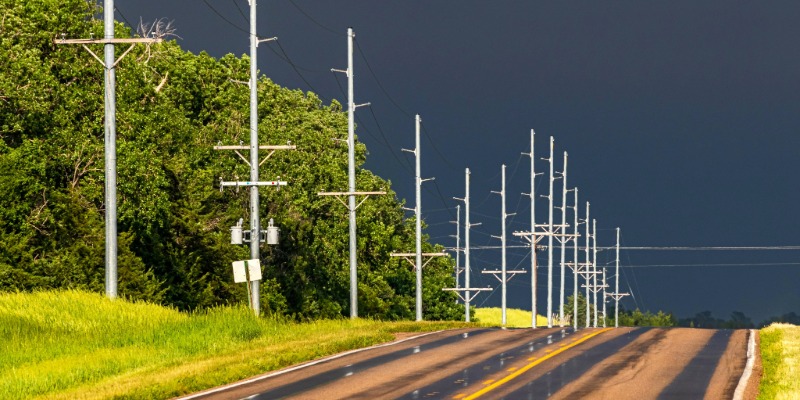Grid-Edge Resilience: Stop Riding Out the Storm
Back to Top
Weather is beating up the grid worse than ever. From 2000 to 2023, weather caused 80% of major U.S. power outages—twice as many outages in the last decade alone. Yet, proving the business case for resilience upgrades remains a challenge. The costs are real, but the benefits are hard to quantify, let alone monetize.
Meanwhile, a high percentage of preventable outages from transient causes like tree branches and storm debris cause frequent disruption. Every outage requires a truck roll, and restoration becomes a dangerous waiting game where some customers win quick while others experience extended time in the dark.
This is where smarter infrastructure can make all the difference.
Automation Protects Lines & Customers
Grid-edge automation can detect and isolate faults, restore power quickly when possible, and minimize outage impact when it can’t.
The technology has ROI that can reduce O&M costs and free up time and capital for modernization projects like concrete power poles and underground residential circuits.
The solutions boost reliability, customer satisfaction, and your bottom line.
The proof is in the performance. Here are three real-world examples from S&C customers who used automation to strengthen grid resilience and found measurable success.
Real Results: 3 Business Cases for Resilience Upgrades
Florida Power & Light Company (FPL)
Challenge:
FPL is an investor-owned utility that serves more than 6 million customers, with a high percentage living near the Florida coastline. The unique geography presents some exceptional challenges including salt-spray erosion, frequent hurricanes and tropical storms, and the highest lightning strike rate in North America. FPL needed a resilient solution to meet ever-rising customer expectations for power reliability despite the inherent regional conditions.
Solution:
In addition to its own Storm Secure Program aimed at grid hardening, FPL turned to S&C for assistance with smart-grid automation to reduce momentary and permanent outages on blue-sky and storm days. Products included:
- 4,000+ IntelliRupter® PulseCloser® Fault Interrupters on feeders
- 80,000 TripSaver® II Cutout-Mounted Reclosers on overhead laterals
Results:
- 4.2 million customer interruptions avoided within the first six years
- 71% reduction in momentary interruptions over 11 years, with a 93% reduction in customer complaints despite a 36% increase in new customer connections over the same period
- 8-day improvement in complete post-hurricane restoration time
- Winner of multiple ReliabilityOneTM National Reliability Excellence Awards by PA Consulting
Alabama Power
Challenge:
Alabama Power (subsidiary of Southern Company) is the largest electric utility in Alabama, serving 1.5 million customers in the southern two-thirds of the state. This area is one of the most storm-prone locations in the country. The utility found that fuse-protected laterals were cutting power to customers for temporary faults, requiring costly truck rolls for fuse replacement in rural areas and impacting reliability and customer satisfaction.
Solution:
The utility worked with S&C to roll out TripSaver II reclosers in a staged plan. The pilot started with 20 units in Birmingham and expanded to 100 statewide. Based on the strong results, Alabama Power has more than 4,000 TripSaver II reclosers installed as part of its grid-modernization program.
Results:
- 106,947 customer minutes saved, along with tens of thousands in O&M savings, from initial pilot
- 70% improvement in System Average Interruption Frequency Index (SAIFI) and a 57% improvement in System Average Interruption Duration Index (SAIDI) for the second deployment
- 6,000+ interruptions eliminated annually with 4,000+ devices deployed
Pohnpei Utilities Corporation (PUC)
Challenge:
PUC is a state-owned utility serving electricity to more than 44,000 people on Pohnpei Island in the Federated States of Micronesia. The remote island nation faced major reliability challenges from temporary faults causing sustained outages. Fast-growing vegetation in one of the wettest parts of the globe was a common contributor. Their grid had three main feeders distributing power across the island. As a result, single faults affected large populations and drove up operating costs.
Solution:
PUC turned to S&C for a long-term, economical solution. The utility deployed the TripSaver II recloser, starting with a three-unit pilot on main feeders for six months where temporary fault rates and vegetation-related glitches were highest. Thanks to proven ROI, they deployed nine additional units afterward, with plans for systemwide deployment.
Results:
- 59 temporary outages kept from becoming permanent
- 59 repair trips avoided, translating into O&M savings
- Reduced repair costs enabled resource reallocation for infrastructure maintenance and efforts to shift to renewable power sources
How to Make the Case Yourself
As severe weather events grow more frequent and intense, the case for resilience has never been clearer — or more urgent.
With each storm comes a surge in lateral disturbances, creating more opportunities to realize the ROI of proven solutions like the TripSaver II recloser. Its seamless integration, measurable impact on customer satisfaction, and ability to deliver early wins make it a smart investment for building long-term momentum. And with S&C’s Technology Assessment program, you don’t have to take our word for it. We’ll help you prove its value.
Let’s stop riding out the storm — and start getting ahead of it.
Need to boost resilience with a solution that offers ROI?
Contact S&C. We’ll help you identify your most problematic areas and turn them into opportunities for improvement with a TripSaver® II Cutout-Mounted Recloser pilot program.